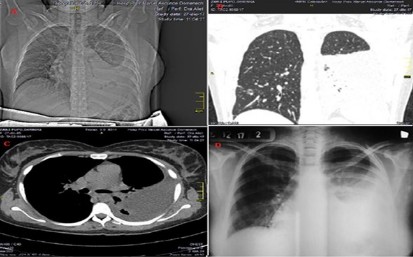Uso de estreptoquinasa recombinante intrapleural en una mujer embarazada con empiema pleural

Resumen
Fundamento: la neumonía complica el 0,78-2,7 por 1 000 embarazos al estar en riesgo la madre y el feto. El empiema como complicación de una neumonía en una paciente embarazada agrega un alto índice de morbimortalidad para la madre y el feto si no se actúa de forma rápida.
Objetivo: describir el caso de una mujer de 33 semanas de embarazo, la cual desarrolló un empiema pleural producto de una complicación de una neumonía adquirida en la comunidad tratada con fibrinólisis intrapleural.
Caso clínico: paciente gestada de 33 semanas, asmática ingresada en el servicio de terapia intensiva del Hospital Universitario Manuel Ascunce Domenech con el diagnóstico de neumonía grave adquirida en la comunidad complicada con derrame paraneumónico el cual evolucionó hacia el empiema. El mismo fue tratado con tubo de toracostomía y terapia fibrinolítica, con buena evolución clínica y radiológica.
Conclusiones: la estreptoquinasa recombinante se puede utilizar de manera segura y efectiva para el manejo del empiema pleural, como agente fibrinolítico intrapleural, durante el embarazo.
DeCS: COMPLICACIONES DEL EMBARAZO; ESTREPTOQUINASA/uso terapéutico; EMPIEMA PLEURAL/tratamiento farmacológico; EMPIEMA PLEURAL/complicaciones; FIBRINOLÍTICOS.
Referencias
Munnell ER. Thoracic drainage. Ann Thorac Surg. 1997;63(5):1497-502.
Miller JI. The history of surgery of empyema, thoracoplasty, Eloesser flap, and muscle flap transposition. Chest Surg Clin N Am. 2000;10(1):45-53.
Burgess JR, Smith B, Britt R, Weireter L, Polk T. Predicting Postoperative Complications for Acute Care Surgery Patients Using the ACS NSQIP Surgical Risk Calculator. Am Surg. 2017;83(7):733-8.
Oshodi T, Carlan SJ, Busowski M, Sand ME. Video assisted thoracic surgery in a second trimester pregnant woman with thoracic empyema: a case report. J Reprod Med. 2015;60(3-4):172-4.
Liao JP, Wang GF, Jin Z, Qian Y, Deng J, Que CL. Severe pneumonia caused by adenovirus 7 in pregnant woman: Case report and review of the literature. J Obstet Gynaecol Res. 2016;42(9):1194-7.
Altmann E. Efficacy of intrapleural instillation of fibrinolytics for treating pleural empyema and parapneumonic effusion: appropriateness of including paediatric trials in meta-analysis. Clin Respir J. 2016;10(5):676.
Zago M, Bozzo S, Carrara G, Mariani D. Failure to Rescue, Rescue Surgery and Centralization of Postoperative Complications: A Challenge for General and Acute Care Surgeons. Chirurgia (Bucur). 2017;112(5):538-45.
Reichert M, Hecker M, Witte B, Bodner J, Padberg W, Weigand MA, et al. Stage-directed therapy of pleural empyema. Langenbeck Arch Surg. 2017;402(1):15-26.
Redden MD, Chin TY, van Driel ML. Surgical versus non‐surgical management for pleural empyema. Cochrane Database of Systematic Reviews [Internet]. 2017 [citado 22 Ago 2018];3(CD010651):[aprox. 59 p.]. Disponible en: https://www.cochranelibrary.com/cdsr/doi/10.1002/14651858.CD010651.pub2/full
Rahman NM. Intrapleural agents for pleural infection: fibrinolytics and beyond. Curr Opin Pulm Med. 2012;18(4):326-32.
Birkenkamp K, O'Horo JC, Kashyap R, Kloesel B, Lahr BD, Daniels CE, et al. Empyema management: A cohort study evaluating antimicrobial therapy. J Infect. 2016;72(5):537-43.
Dabo H, Meira L, Neves I, Marinho A, Gomes I. Combined intrapleural therapy in infectious pleural effusion. Rev Port Pneumol. 2015;21(2):105-6.
Ferreiro L, San Jose ME, Valdes L. Management of Parapneumonic Pleural Effusion in Adults. Arch Bronconeumol. 2015;51(12):637-46.
Tillett WS, Sherry S. The effect in patients of streptococcal fibrinolysin and streptococcal desoxyribonuclease on fibrinous, purulent, and sanguinous pleural exudations. J Clin Invest. 1949;28(1):173-90.
Idell S, Florova G, Shetty S, Tucker T, Idell R, Koenig K, et al. Precision-guided, Personalized Intrapleural Fibrinolytic Therapy for Empyema and Complicated Parapneumonic Pleural Effusions: The Case for the Fibrinolytic Potential. Clin Pulm Med. 2017;24(4):163-9.
Nie W, Liu Y, Ye J, Shi L, Shao F, Ying K, et al. Efficacy of intrapleural instillation of fibrinolytics for treating pleural empyema and parapneumonic effusion: a meta-analysis of randomized control trials. Clin Respir J. 2014;8(3):281-91.
Breen DP, Daneshvar C. Role of interventional pulmonology in the management of complicated parapneumonic pleural effusions and empyema. Respirology. 2014;19(7):970-8.
Raymond D. Surgical intervention for thoracic infections. Surg Clin North Am. 2014;94(6):1283-303.
Worrell SG, Demeester SR. Thoracic emergencies. Surg Clin North Am. 2014;94(1):183-91.
Davies HE, Davies RJ, Davies CW, Group BTSPDG. Management of pleural infection in adults: British Thoracic Society Pleural Disease Guideline 2010. Thorax. 2010;65 Suppl 2: 41-53.
Enlaces refback
- No hay ningún enlace refback.

Esta obra está bajo una licencia de Creative Commons Reconocimiento-NoComercial-CompartirIgual 4.0 Internacional.










 La Revista está: Certificada por el CITMA
La Revista está: Certificada por el CITMA Acreditados como: "Web de Interés Sanitario"
Acreditados como: "Web de Interés Sanitario"
